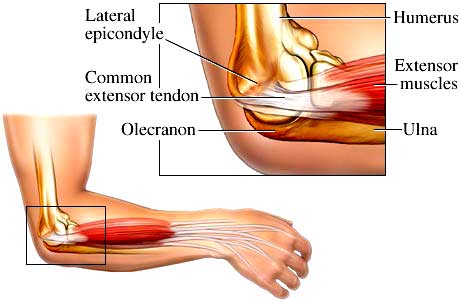After being glued to the TV most evenings watching the Australian Open I thought a topical discussion for the beginning of 2016 would be the common elbow complaint known as tennis elbow. Now of course we all know that tennis elbow does not always involve tennis and in fact, in reality, tennis players only make up a small proportion of patients with these injuries.
Tennis elbow generally presents as pain on the outside of your elbow with gripping and lifting movements. The injury itself is to the tendons of the extensor muscles of the forearm and their attachments at the lateral epicondyle (which is the bony lump on the outside of your elbow). Generally the main muscle involved is the extensor carpi radialis brevis (ECRB).
Clinically we call this condition lateral epicondylagia and it is where the tendons (the structure that attaches the muscle to the bone) become worn down through excessive use, a little bit like a rope that has become frayed. This is called a tendinopathy. There can also be situations where the bony attachment also becomes involved which is called an ensthesopathy, but for this discussion we will focus on the tendon. The position of these structures can be seen in the diagram below.

This condition is very common, with studies suggesting that 40% of people will experience some form of this injury through their lives. As well as being common these symptoms can take a long time to fully resolve with recent reports indicating it can be a number of years to be totally pain free.
It is most commonly experienced in the dominant arm and is a result of repetitive wrist extension. This can be from prolonged typing at a key board, a morning of lifting bricks in the garden or even a poor backhand technique in tennis!
Another important factor when looking at tennis elbow is the association it has with spinal and shoulder impairments. Evidence has shown that people with tennis elbow complaints are more likely to have neck pain than healthy counterparts. A link has also been found between weakness through the rotator cuff of the shoulder and tennis elbow.
However it is not all bad news. If the symptoms are diagnosed and managed early and there is minimal involvement of the cervical spine or shoulder then this condition does respond well to treatment and can have a good outcome. Therefore assessment is very important, as a clear diagnosis will give a good idea as to the prognosis of the injury. The table below gives a quick look at what presentations are likely to have the best outcomes.
|
Slow recovery |
Speedy recovery |
|
• Over 3 month history of pain
|
• Short history of symptoms - under 3 weeks
|
There are many different treatment modalities that we as physiotherapists have at our disposal to treat tennis elbow. I personally find joint mobilisations, dry needling and taping to be very beneficial and these treatments have evidence of being effective, particularly with patients who fit the 2nd column of the above table. However, one of the most beneficial intervention we can give as physiotherapists is education on the injury itself and correcting abnormal lifting or movement biomechanics which may have lead to the injury in the first place. This will often involve conditioning and mobility exercises for the spine or the shoulder, as well as the elbow and can result in changing a desk set up or a lifting technique.
To conclude, tennis elbow symptoms are very common and although they can often be unresponsive to treatments if you are able to get assessed by a physiotherapist in the early stages then you will have a greater chance of a better outcome. So the most important advice I can give is to get assessed by your physio or GP sooner rather than later.
